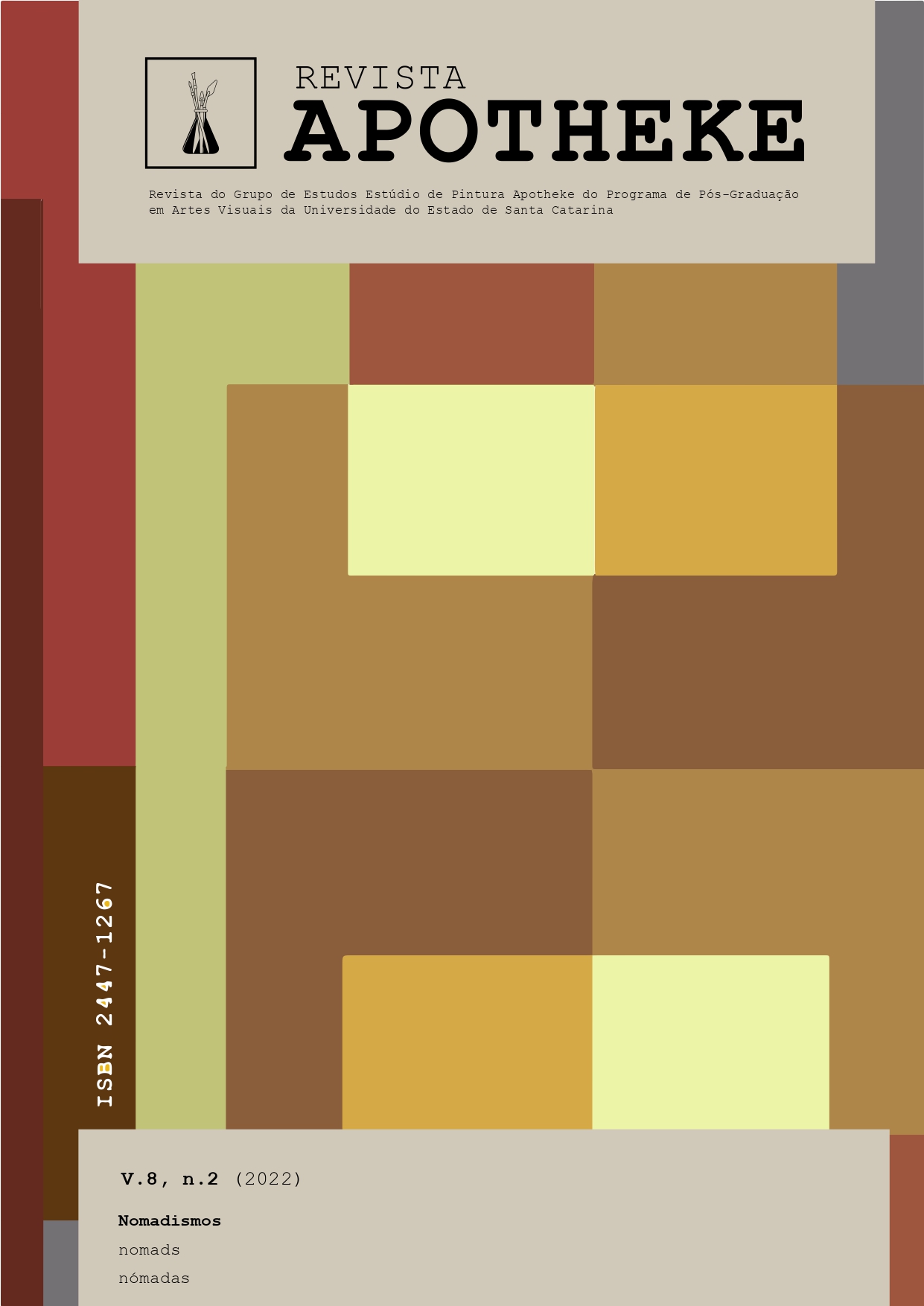An endogenous visual process with nomadism of means and images
DOI:
https://doi.org/10.5965/24471267822022200Keywords:
endogenous image, exogenous image, etchingAbstract
This visual essay is a clipping of a broader research that involves the migration of images produced at different times, which migrate as nomads from one medium to another in order to integrate with the time and space in which I live today, a reflection of my migration to Marabá, a city located in the Amazon paraense and place at the same time diverse and antagonistic to that of my origin. The choices are somehow the result of this antagonism, the distance traveled by the migration of region brought me closer to myself, perhaps the effect of the Amazon distances that so vast, seem at each step so far more further, contributing to an endogenous visual process, in which images of the past are invariably engendered by exogenous perception that never moves away, as a need for visual art to incorporate, exchange and simulate in their means the human experience of life, themselves, dumb and inert bodies but fully capable of induce the thought to those who in the fruition animate them. Two experiments will be shown, in one, the image of a recent painting and photograph migrate to a 23-year-old ago etching plate, and the other an old drawing and a recent photograph migrate to a woodcut with historical carving and printing processes and from them to a hybridized print with digital process.
Downloads
References
BEARDON, Colin. Práticas criativas e o projeto de software. In: DOMINGUES, Diana. (org) A Arte e vida no Século XXI: Tecnologia, ciência e criatividade. São Paulo: Editora Unesp, 2003.
BELTING, Hans. Antropologia da imagem: Para uma ciência da imagem. Lisboa: KKYM + EAUM, 2014.
COLI, Jorge. A obra ausente. In: SAMAIN, Etienne. Como pensam as imagens. Campinas: Editora Unicamp, 2012, p.41-50.
JUNG, Carl Gustav. Os arquétipos e o inconsciente coletivo. 2ª ed. Petrópolis: Editora Vozes, 2002.
FOCILLON, Henri. A vida das formas. Rio de Janeiro: Zahar Editores, 1983.
IVINS Jr, William Mills. Imagen y conocimiento: Análisis de la imagen prefotográfica. Barcelona: Editorial Gustavo GiIi. S.A, 1974.
LAURENTIZ, Paulo. Holarquia do Pensamento Artístico. Campinas: Editora Unicamp, 1991.
LE'VI-STRAUSS, Claude. O pensamento selvagem. 2ª ed. São Paulo: Papirus Editora, 1997.
MARTINS, Itajahi. Gravura: Arte e técnica. São Paulo: Fundação Nestlé Cultura, 1987.
MENEZES, Philadelpho. Oralidade no experimento poético brasileiro. In: DOMINGUES, D. (Org.) A Arte no Século XXI: A Humanização das Tecnologias. São Paulo: Fundação da Editora da Unesp, 1997, p. 272-281.
SALLES, Cecilia Almeida. Redes da criação: construção da obra de arte. 2ª ed. Vinhedo: Editora Horizonte, 2008.
SARTRE, Jean-Paul. Imaginação. 1ª. Ed. Porto Alegre: L& PM Pocket, 2008.
Downloads
Published
How to Cite
Issue
Section
License
Copyright (c) 2022 Wilson Roberto da Silva

This work is licensed under a Creative Commons Attribution-NonCommercial 4.0 International License.
Copyright and Licensing Policy
Authors of works submitted to Revista APOTHEKE authorize their publication in both print and digital formats exclusively for academic purposes. Reproduction is permitted, provided that the source is properly cited. Authors confirm the originality, authorship, and unpublished status of their manuscripts.
Articles published by the journal are freely available and intended for academic and non-commercial use only. All copyrights are transferred to the journal. The content of signed articles reflects the views of their respective authors and not the official position of Revista Apotheke. The author(s) agree to always cite the following reference when republishing or referring to the content originally published in Revista Apotheke:
“This article was originally published by Revista Apotheke in volume (insert volume), number (insert number), year (insert year), and is available at: http://www.revistas.udesc.br/index.php/APOTHEKE/index”
It is the sole responsibility of the authors to obtain written permission for the use of any material protected by copyright law included in their articles. Revista Apotheke is not responsible for copyright infringements committed by contributors.
Authors retain copyright and grant the journal the right of first publication, with the work licensed under a Creative Commons Attribution-NonCommercial License (CC BY-NC):
-
Attribution (BY): Licensees are allowed to copy, distribute, display, perform, and create derivative works, provided that proper credit is given to the author or licensor, in the manner specified.
-
NonCommercial (NC): Licensees may use the material only for non-commercial purposes.
After publication, authors retain the rights to their work and may republish the text.



